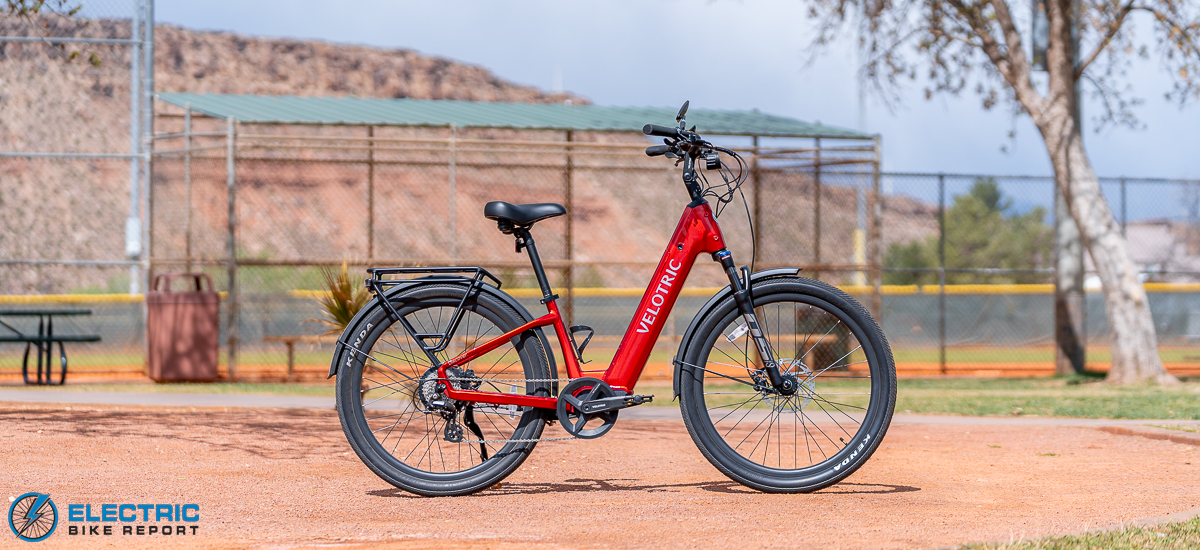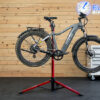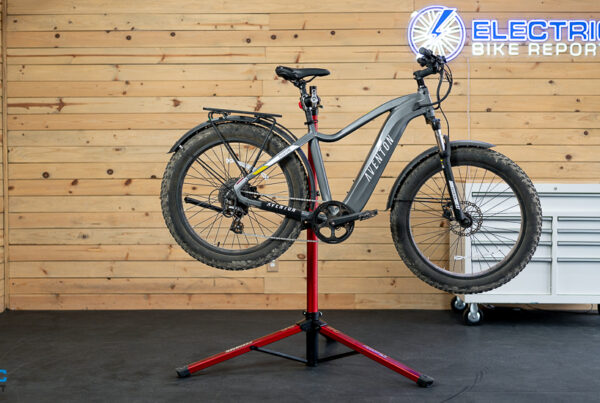Ride quality is a broad term that relates to how a bike feels to ride. The Discover 2’s ride quality was excellent overall, though it is important to break this aspect of the bike down further into its many smaller elements.
As discussed previously in this Velotric Discover 2 review, the bike excelled at comfort; its contact points (saddle, pedals, and handlebars) prioritized ergonomics so I was able to enjoy long test rides of 1-2 hours with no discomfort.
The wide handlebars stood out as an unexpected highlight, providing comfort and excellent control over the steering. The bike’s handling was elevated as a result, with a more responsive and agile feel than I expected.
It is worth noting that I exceeded the recommended height range of our test bike, as we evaluated the Regular frame, which fits riders from 4’11” to 5’9”. At 5’11”, I am better suited to the Large, which accommodates taller riders from 5’6” to 6’4”.
Regardless, I was able to find a nearly perfect fit thanks to the bike’s long seatpost—with 8” of adjustability in saddle height—and the adjustable stem, which can adjust handlebar height and reach.
The bike’s torque sensor was one area with room for improvement, though we noticed a difference in one riding mode following a recent firmware update. We appreciated the increased responsiveness over the cadence sensor on the Discover 1; however, the Discover 2 required more effort than expected to access the motor’s full power.
Many torque sensors respond fluidly to small changes in downward pressure on the pedals, but in Eco and Trail modes, the Discover 2 required intentional, consistent pressure throughout the pedals’ full rotation. This was not an issue in Boost, but we encourage Velotric to update at least Trail mode’s power output or sensitivity in the future.
Otherwise, the Discover 2 featured a number of uncommon features we appreciated—especially for its price range. Perhaps most notable was a cruise control feature that, when activated at any speed above five mph, allows the bike to maintain speed with no pedal effort or holding of the throttle lever.
Additionally, while the bike offers customization through its settings menu, it pairs with Velotric’s app for quicker, on-the-go adjustment of speeds, riding modes, sensor modes, and features. Users can switch between automatic and manual light system activation, decide if/when the tail lights and brake lights flash, and more.
As with some of Velotric’s other e-bikes, the Discover 2 is also compatible with Apple Find My™, which can aid users in locating their e-bike in the event of theft. As long as the bike is near a phone with Bluetooth connectivity, its location can be transmitted and tracked through Apple’s app.
In terms of accessories, Velotric offers cargo baskets, a side mirror, an upgraded saddle, a trailer hitch, a twist-throttle upgrade, etc. Our test bike included the side mirror, which I found extremely useful on my morning and evening commutes to/from the office.
The included MIK-HD cargo rack has a higher-than-average 66-lb weight capacity and is compatible with various MIK-specific storage baskets/bags that lock into place. This standardized system is even compatible with a child seat, making the Discover 2 effectively a hybrid commuter/utility bike.
We appreciated some of the bike’s smaller touches as well. Things like the spring-loaded hinge on the charging port were especially cool, as most bikes use rubber caps that are tough to get positioned right. This hinge was easy to use and it kept the port protected.
The Discover 2 is undeniably and impressively feature-packed. Some of its included elements are becoming increasingly more common on bikes priced between $1500 and $2000, but Velotric managed to raise the bar with a number of unexpected extras.
.
.
.
#Velotric #Discover #Review #Electric #Bike #Report
Source link








